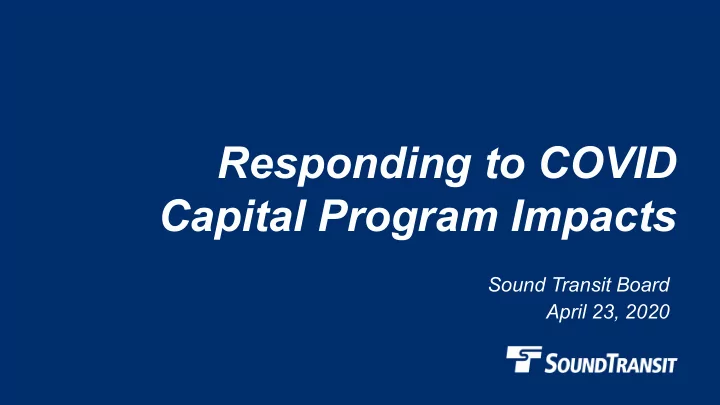

Responding to COVID Capital Program Impacts Sound Transit Board April 23, 2020
Why we are here Informational and discussion only, no Board action required • Discuss possible COVID effects on our capital program. • Revisit Board precedent from last recession. • Frame possible agency responses. 2
We’ve been here before Sound Transit’s response to the Great Recession after ST2 • 25% initial revenue loss. • Board held workshops to guide response. • Board modified system plan to reduce, reschedule, suspend, or cancel select projects. 3
Sept. 2010 Board workshop Project realignment priorities High priorities • Achieve goals of voter-approved system plan. • Preserve projects underway or near completion. • Maintain assets. 4
Sept. 2010 Board workshop Project realignment priorities Lower priorities • Projects meeting fewer System Plan goals. • Discretionary programs. • Maintaining project reserves. • Projects with undefined scope or uncertain partner commitments. • Projects or services with low ridership. 5
ST2 project realignment categories Design & construct as planned. Continue with schedule and affordability risk. Retain limited funding to develop future options. Suspend indefinitely and remove from finance plan. Delete project from program entirely. 6
Uncertain future finances Data available • March national retail sales: 8.7% in March • Unemployment claims: 26 million in last 5 weeks • ST Ridership loss: 86% • Federal assistance available:$166 million Data not yet available • March and April actual tax receipts. • Duration of WA State social distancing. • Length and depth of recession. 7
Program Funding sources (2017-2041: $97.9B) • Tax revenues fund 67% of Debt the program. 18% • Debt funds 18%. Fares • Fares fund 7%. 7% Sales Tax 53% All above funding sources Grants 8% will be negatively impacted by a recession. MVET Property 9% 5% 8 8
Revenue shortfall as a result of the recession Revenu e shortfall • As revenue sources shrink as a proportion Sales Tax of the total program, Debt more debt will be issued to make up for some or all of the shortfall. Fares MVET Grants Property *Conceptual illustration 9 9
*Conceptual illustration Insufficient funding would require adjustment to the Funding gap program Higher • When funding need exceeds debt Sales available debt capacity, the up to Tax program becomes capacity unaffordable. limits • One of the debt capacity constraints is based on Fares regional property values, which is also likely to decline Grants MVET in a recession. Property 10 1
Recession threatens program affordability • Mild scenario: similar to dot com recession (2002) • Severe scenario: similar to great recession (2008) Debt Capacity - Fall 2019 vs Recession Scenarios $45 Principal Balance as Forecasted in Fall 2019 Debt Capacity $40 Principal Balance as Forecasted with Dot Com Recession $35 Principal Balance as Forecasted with Great Recession $30 Debt Capacity as Forecasted in Fall 2019 Billions of YOE$ $25 $20 $15 $10 $5 $- 2020 2021 2022 2023 2024 2025 2026 2027 2028 2029 2030 2031 2032 2033 2034 2035 2036 2037 2038 2039 2040 2041 11
Revenue and Capacity Impact 2020-2041 (YOE$ in millions) Dot Com Great Recession Recession Loss of revenue -$5.6 Billion -$11.9 Billion As % of remaining capital -11.8% -25.2% Loss of debt capacity -$4.9 Billion -$14.5 Billion As % of remaining capital -10.5% -30.8% Remaining capital (includes 2020): $47.2 Billion 12 `
Board tools to manage affordability • Extend the time to complete the system. • Modify project scope. • Secure new grant funding or funding partners. • Suspend or delete projects. • Request a further tax increase from the legislature and voters. 13
ST Board’s Core Priorities for ST3 Elements of good design 14
CEO’s near-term approach Maintain Board’s flexibility and readiness for uncertain future Keep construction going safely • Northgate, East Link, Lynnwood, Federal Way, Downtown Redmond, Hilltop Tacoma Link, OMF East. 15
CEO’s near-term approach Maintain Board’s flexibility and readiness for uncertain future Continue work in planning and final design • Maintain readiness for variable revenue/grant scenarios. • Slower, more incremental approach in some instances as longer-term realignment takes shape. 16
CEO’s near-term approach Maintain Board’s flexibility and readiness for uncertain future Hold on moving further projects into final design or construction • Avoid over-commitment until Board priorities become clearer. 17
Board discussion schedule Board, Executive Committee, Finance & Audit Committee April Establish context & process May Board workshop (History, context) June Board workshop (Criteria, options, evaluation) July Establish initial project priorities Fall Review project priorities via 2021 budget process 18
Thank you. soundtransit.org
Recommend
More recommend